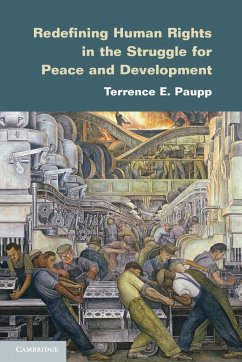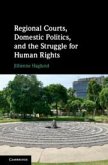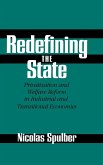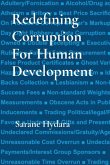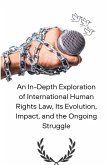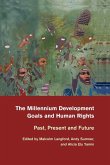Terrence E. Paupp
Redefining Human Rights in the Struggle for Peace and Development
Terrence E. Paupp
Redefining Human Rights in the Struggle for Peace and Development
- Broschiertes Buch
- Merkliste
- Auf die Merkliste
- Bewerten Bewerten
- Teilen
- Produkt teilen
- Produkterinnerung
- Produkterinnerung
Examines the history of the struggle to advance human rights and provides a global framework of constitutional protections to implement these rights.
Andere Kunden interessierten sich auch für
![Regional Courts, Domestic Politics, and the Struggle for Human Rights Regional Courts, Domestic Politics, and the Struggle for Human Rights]() Jillienne HaglundRegional Courts, Domestic Politics, and the Struggle for Human Rights123,99 €
Jillienne HaglundRegional Courts, Domestic Politics, and the Struggle for Human Rights123,99 €![Redefining the State Redefining the State]() Nicolas SpulberRedefining the State78,99 €
Nicolas SpulberRedefining the State78,99 €![Redefining Corruption For Human Development Redefining Corruption For Human Development]() Sarane HydaraRedefining Corruption For Human Development13,99 €
Sarane HydaraRedefining Corruption For Human Development13,99 €![The Struggle for Human Rights in Latin America The Struggle for Human Rights in Latin America]() Edward ClearyThe Struggle for Human Rights in Latin America36,99 €
Edward ClearyThe Struggle for Human Rights in Latin America36,99 €![An In-Depth Exploration of International Human Rights Law, Its Evolution, Impact, and the Ongoing Struggle An In-Depth Exploration of International Human Rights Law, Its Evolution, Impact, and the Ongoing Struggle]() An In-Depth Exploration of International Human Rights Law, Its Evolution, Impact, and the Ongoing Struggle29,99 €
An In-Depth Exploration of International Human Rights Law, Its Evolution, Impact, and the Ongoing Struggle29,99 €![Redefining Ceasefires Redefining Ceasefires]() Marika SosnowskiRedefining Ceasefires101,99 €
Marika SosnowskiRedefining Ceasefires101,99 €![The Millennium Development Goals and Human Rights The Millennium Development Goals and Human Rights]() The Millennium Development Goals and Human Rights60,99 €
The Millennium Development Goals and Human Rights60,99 €-
-
-
Examines the history of the struggle to advance human rights and provides a global framework of constitutional protections to implement these rights.
Produktdetails
- Produktdetails
- Verlag: Cambridge University Press
- Seitenzahl: 582
- Erscheinungstermin: 10. April 2014
- Englisch
- Abmessung: 229mm x 152mm x 31mm
- Gewicht: 831g
- ISBN-13: 9781107669314
- ISBN-10: 1107669316
- Artikelnr.: 39632955
- Herstellerkennzeichnung
- Libri GmbH
- Europaallee 1
- 36244 Bad Hersfeld
- gpsr@libri.de
- Verlag: Cambridge University Press
- Seitenzahl: 582
- Erscheinungstermin: 10. April 2014
- Englisch
- Abmessung: 229mm x 152mm x 31mm
- Gewicht: 831g
- ISBN-13: 9781107669314
- ISBN-10: 1107669316
- Artikelnr.: 39632955
- Herstellerkennzeichnung
- Libri GmbH
- Europaallee 1
- 36244 Bad Hersfeld
- gpsr@libri.de
Terrence E. Paupp is the Vice-President, North America, of the International Association of Educators for World Peace (IAEWP) and Senior Research Fellow at the Council on Hemispheric Affairs (COHA), Washington, DC. He is the author of numerous books, most recently Beyond Global Crisis: Remedies and Road Maps by Daisaku Ikeda and his Contemporaries (2012); The Future of Global Relations: Crumbling Walls, Rising Regions (2009); Exodus from Empire: The Fall of America's Empire and the Rise of the Global Community (2007); and Achieving Inclusionary Governance: Advancing Peace and Development in First and Third World Nations (2000).
1. The greatest undiagnosed problem in international law; 2. From disparity
to centrality: how the human rights to peace and development can be
secured; 3. Confronting structural injustice: strategies of localization,
regionalism, and an emerging 'global constitutional order'; 4. The power of
law vs. the law of power: how human rights can overcome inequality,
poverty, and vested interests; 5. A world community that includes all human
communities: indigenous communities and the global environment as sources
for human rights claims; 6. Actualizing the human right to peace: paths for
developing processes and creating conditions for peace; 7. Transformation
through cooperation: implementing a human rights-based approach to human
security, peace, and development.
to centrality: how the human rights to peace and development can be
secured; 3. Confronting structural injustice: strategies of localization,
regionalism, and an emerging 'global constitutional order'; 4. The power of
law vs. the law of power: how human rights can overcome inequality,
poverty, and vested interests; 5. A world community that includes all human
communities: indigenous communities and the global environment as sources
for human rights claims; 6. Actualizing the human right to peace: paths for
developing processes and creating conditions for peace; 7. Transformation
through cooperation: implementing a human rights-based approach to human
security, peace, and development.
1. The greatest undiagnosed problem in international law; 2. From disparity
to centrality: how the human rights to peace and development can be
secured; 3. Confronting structural injustice: strategies of localization,
regionalism, and an emerging 'global constitutional order'; 4. The power of
law vs. the law of power: how human rights can overcome inequality,
poverty, and vested interests; 5. A world community that includes all human
communities: indigenous communities and the global environment as sources
for human rights claims; 6. Actualizing the human right to peace: paths for
developing processes and creating conditions for peace; 7. Transformation
through cooperation: implementing a human rights-based approach to human
security, peace, and development.
to centrality: how the human rights to peace and development can be
secured; 3. Confronting structural injustice: strategies of localization,
regionalism, and an emerging 'global constitutional order'; 4. The power of
law vs. the law of power: how human rights can overcome inequality,
poverty, and vested interests; 5. A world community that includes all human
communities: indigenous communities and the global environment as sources
for human rights claims; 6. Actualizing the human right to peace: paths for
developing processes and creating conditions for peace; 7. Transformation
through cooperation: implementing a human rights-based approach to human
security, peace, and development.

